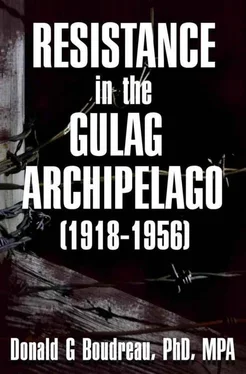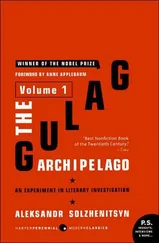— Alexander I. Solzhenitsyn (1972) Excerpted in part from “Lake Segden,” in Solzhenitsyn,
Stories and Prose Poems , at 198-9.
I dedicate this
to all those who did not live
to tell it.
And may they please forgive me
for not having seen it all,
for not having divined all of it.
So begins The Gulag Archipelago , Alexander Solzhenitsyn’s history of Soviet police terror and the sub-human prison camp network. It is less important for what it says then for what it leaves unsaid. This detailed account of living death in the Soviet Union from 1918 to 1956 takes on its true importance from the suggestion that the police system it describes continues to this day. The infamous network of slave labor camps remains in operation, even if the numbers imprisoned have been vastly reduced, since the amnesties granted during the Nikita Khrushchev regime.
One day, Mr. Solzhenitsyn clearly hoped, his account shall play a role in bringing the Soviet people to rise up and end the decades of oppression which they have so far accepted with such docility. That day is unlikely to come soon as Solzhenitsyn indicates, for the Soviet secret police is the central vital element-even more perhaps than the Communist party machine—in binding the Soviet system together.
The network of camps, prisons, communication facilities, transportation systems and spying organizations, Solzhenitsyn reports, “honeycombs” the length and breadth of the Soviet Union. It appears that no Soviet citizen is ever more than a short distance from some link of this pervasive apparatus of control that permeates all governmental, party and social organizations. The survival of this infrastructure makes it less significant that the actual prison camp population has fallen from an estimated twelve million during Stalin’s reign of terror to perhaps one million today.
Much of what Solzhenitsyn reports had long been known in the West. Yet, this was the first time that an authoritative voice of stature has spoken from Moscow itself to inform the Soviet people in detail of their tragedy and to call for punishment of its perpetrators. Solzhenitsyn’s courageous challenge to the overwhelming power of the police state is a political act without real precedent in the fifty-odd years since the Bolshevik Revolution.
Solzhenitsyn has shown us that his mission is not merely to accuse but rather, to search for remedies that would help the individual overcome the suppression and fear found in a totalitarian regime. My conceptual framework indicates that Stalin was not engaged in a real struggle with counter-revolutionaries. Logic dictates that Stalin acted inimically to his own revolutionary calling.
The main tendency of Stalinist mass repression during the period 1936-1938 was an assault on the Party, on old Bolshevik cadres, on proletarian revolutionaries, on the intelligentsia that were honorably serving the interests of the masses. This study centers upon the question of resistance, dissent, and protest in The Gulag Archipelago. The question reiterates through our minds as it had that of Solzhenitsyn’s — “But can there really be a whole nation of fools?”
My orientation vehemently conjectures that economic and social progress would have been much greater if Stalin had not destroyed thousands upon thousands of scientists, engineers, teachers, doctors, and writers. The solidarity between the people and the government would have been much stronger had there been no mass repression. The people would have shown the Central Committee more confidence if the beau monde in the Party, government, economic and military apparatus had not been destroyed in the mid-thirties. Stalin can no longer be placed alongside Marx, Engels, and Lenin. He must stand alone.
The question usually asked by outsiders, [W]hy did the Jews of Nazi Germany not offer more resistance?” becomes radically obscene in the face of the Warsaw Ghetto Uprising and Treblinka. Granted, there was never an exodus of a major part of the Jews of the ghettos, but in 1942-1943 as the eastern ghettos were being destroyed, small groups of Jews escaped to the woods in a desperate bid for survival and vengeance.
Where is the Warsaw Ghetto Uprising of the Stalinist reign of terror? Where are the six hundred prisoners armed with stolen guns and grenades attacking the Nazi guards, literally blowing up the death houses at Treblinka, and fleeing into the nearby Polish forests? Where are the suicide missions? How could the Russian people have gone to their incarceration, torture, and slaughter like lambs? Was fear of government retaliation so pervasive in the Soviet mind that it negated any and all forms of resisting, dissenting, and protesting? Why did the Jews, despite their relative few in number and the lateness of the hour, arm themselves in rebellion, while the Soviets of this period appear as pacifists in the face of a system which exemplified dialectical terrorism?
Nazi anti-Semitism condemned the Jews as an “alien element” in the body of the nation, thus making them a merciless target of any punishment the deranged minds of totalitarian nationalists were capable of inventing with the help of modern technology. Somewhat similarly, totalitarian Communism condemns the “class enemy” as an alien element within the society. And a madly totalitarian regime, such as Stalin’s, is capable of dealing with it accordingly.
What makes the critical analysis of these atrocious modern evils often so difficult is that they are connected with highly popular, ideologies and mass movements. The idea of nationalism is history’s “first world religion,” as the late Hans Kohn so aptly referred to it. And, to all evidence, the so-called Marxist class structure too is well underway to becoming another world religion. Small wonder it is that even the most articulate and intelligent critics of such successful movements are easily sidetracked. There is, of course, no lack of clear-sighted and courageous commentators on contemporary affairs who are placing these brutal phenomena of our century in proper critical and realistic perspective. Rather, what is lacking is the public ability and willingness to listen to them.
Critics of nationalism and class struggle, not surprisingly, have a particularly difficult time in getting their intellectual messages across in the vulgar confusion of modernity. Two of the worst holocausts of our time, the Hitlerism and the Stalinist — are causes in point to illustrate the ideological malaise which is worldwide.
This paper is write in the hopes that students of law and politics and public administration will seek to confront these “diseases” and “treat” them by educating the public as to their horrendous ramifications. It is unfair to ask more in light of the limitations of the human condition.
This venture is three-fold. First, we will be examining the historically isolated incidents of resistance as they became manifest in the Gulag Archipelago . The relative assessment will prove hopefully to be more precise by referring to historical works of the era such as Roy A. Medvedev’s Let History Judge: The Origins and Consequences of Stalinism (1972) and The Russian Revolution (1966) by Robert Goldston, in addition to our primary source of The Gulag Archipelago (1973) by Alexander Solzhenitsyn.
Second, we will be presenting a literary depiction of resistance in the Gulag camps through two of Alexander Solzhenitsyn’s finest novels, Cancer Ward (1972) and The First Circle (1972). With Solzhenitsyn as a survivor of eight years in concentration camps and three years in exile for his offense (written derogatory remarks about Stalin), his account of literal occurrences is taken here to be nothing short of certitude.
Third and finally, in a state of hopeful culmination, the hypothesis will bear fruit. That being, if there exist no governmental implementation and public support of a criminal justice system acting in the interests of all the people (i.e., the rule of law) then dissent shall be suffocated. Without the existence of established and accessible channels representing the interests and grievances of the population at large, through which all injured parties may seek recourse without threat of governmental terroristic tactics, innocent persons shall suffer undue harm.
Читать дальше












